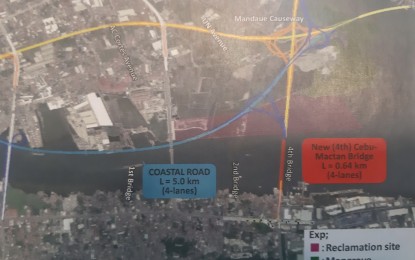
CEBU'S 4TH BRIDGE. A copy of the preparatory survey shows the proposed alignment of the new (4th) Mactan Bridge connecting the cities of Lapu-Lapu and Mandaue, as recommended by the Japan International Cooperation Agency (JICA). (Photo by John Rey Saavedra)
CEBU CITY — Japanese consultants from the Japan International Cooperation Agency (JICA) on Wednesday presented to the planning office of the Department of Public Works and Highways (DPWH)-7 (Central Visayas) the preparatory survey for the new Mactan bridge construction project.
DPWH-7 planning officer Nonato Paylado said JICA recommended the construction of the bridge in order to “mitigate traffic congestion in Metro Cebu.”
Hiroyuki Morimoto, JICA project team head, said the JICA master plan 2019 includes the proposal to construct the bridge that will connect the cities of Lapu-Lapu on Mactan Island and Mandaue in mainland Cebu.
The fourth bridge is needed “to meet the expanding traffic capacity between the two islands generated by the booming Cebu’s industry and tourism,” Hiroyuki said.
Part of the bridge project will be the Mandaue coastal road project, which will be “constructed as an extension of the proposed Metro Cebu circumferential road or proposed Mandaue-Liloan diversion road to divert traffic from the city center through a bypass road,” he said.
The project has a total length of 6.78 kilometers, with a 0.58-kilometer bridge component and a 6.20-kilometer coastal road component, covering both the bridge approach and viaduct.
Spanning over the Mactan channel, the bridge project with four lanes and a 22.2-meter wide roadway will affect Barangays Ibo and Pusok in Lapu-Lapu City and Umapad and Opao in Mandaue City.
It will adopt two interchanges, according to Hiroyuki’s presentation.
The Japanese consultants started the master plan study last December through a series of preparatory meetings, collection of project background data, and site survey.
The consultants are now conducting traffic survey and traffic demand forecast, as well as bridge location and coastal road alignment after their successful two-month long natural condition survey that started last January.
According to the study, JICA experts and stakeholders will address the issue of resettlement for 50 to 70 informal settlers near the landfill in Barangay Umapad in Mandaue City.
It, however, said that the resettlement action plan for the families to be displaced by the project is ongoing.
On Wednesday afternoon, the consultants conducted direct coordination with the managers of different industrial establishments in Mandaue City that may get affected by the construction of the fourth bridge.
Hiroyuki’s presentation, however, said “tenurial instrument” of affected lots and the authority of DPWH-7 to develop them still need to be confirmed.
Presently, the third bridge project called Cebu-Cordova Link Expressway is under construction. Spanning Cordova and Cebu City, it is a public-private partnership (PPP) project undertaken by Cebu-Cordova Link Expressway Corp. (CCLEC).
CCLEC is a joint venture of Acciona Construction of Spain, First Balfour Inc. and D.M. Consunji Inc. of the Philippines. The company is a subsidiary of Metro Pacific Tollways Corp., which will operate the third bridge for a period of 35 years.
CCLEC president and general manager Allan Alfon said the company is confident about finishing the third bridge by 2021, in time for the commemoration of the 500th year of Christianity in the Philippines.
The first Mactan bridge was constructed in 1970 and finished in 1972, while the second, the Marcelo Fernan Bridge, was constructed in 1996 and opened to traffic in 1999. (PNA)
